
The Confederate States Navy (CSN) was the naval branch of the Confederate States Armed Forces, established by an act of the Confederate States Congress on February 21, 1861. It was responsible for Confederate naval operations during the American Civil War against the United States's Union Navy.

CSS Baltic was an ironclad warship that served in the Confederate States Navy during the American Civil War. A towboat before the war, she was purchased by the state of Alabama in December 1861 for conversion into an ironclad. After being transferred to the Confederate Navy in May 1862 as an ironclad, she served on Mobile Bay off the Gulf of Mexico. Baltic's condition in Confederate service was such that naval historian William N. Still Jr. has described her as "a nondescript vessel in many ways". Over the next two years, parts of the ship's wooden structure were affected by wood rot. Her armor was removed to be put onto the ironclad CSS Nashville in 1864. By that August, Baltic had been decommissioned. Near the end of the war, she was taken up the Tombigbee River, where she was captured by Union forces on May 10, 1865. An inspection of Baltic the next month found that her upper hull and deck were rotten and that her boilers were unsafe. She was sold on December 31, and was likely broken up in 1866.

The first Vandalia was an 18-gun sloop-of-war in the United States Navy during the Second Seminole War and the American Civil War. She was named for the city of Vandalia, Illinois.
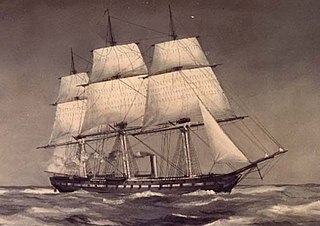
USS Wabash was a steam screw frigate of the United States Navy that served during the American Civil War. She was based on the same plans as Colorado. Post-war she continued to serve her country in European operations and eventually served as a barracks ship in Boston, Massachusetts, and was sold in 1912.
The Stone Fleet consisted of a fleet of aging ships purchased in New Bedford and other New England ports, loaded with stone, and sailed south during the American Civil War by the Union Navy for use as blockships. They were to be deliberately sunk at the entrance of Charleston Harbor, South Carolina in the hope of obstructing blockade runners, then supplying Confederate interests. Although some sank along the way and others were sunk near Tybee Island, Georgia, to serve as breakwaters, wharves for the landing of Union troops, the majority were divided into two lesser fleets. One fleet was sunk to block the south channel off Morris Island, and the other to block the north channel near Rattlesnake Shoals off the present day Isle of Palms in what proved to be failed efforts to block access the main shipping channels into Charleston Harbor.

USS Varuna was a screw steamer acquired by the Union Navy during the American Civil War. Under construction in 1861, she was purchased incomplete on 31 December. After being commissioned in February 1862, she traveled to join the West Gulf Blockading Squadron. Varuna was present when Flag Officer David Glasgow Farragut led an attack against Confederate positions at Fort Jackson and Fort St. Philip on 24 April. During the action, Varuna ran ahead of the other Union ships, and was engaged in a chase with the Louisiana gunboat Governor Moore. After closing in on the Union ship, Governor Moore rammed Varuna twice, with the gunboat CSS Stonewall Jackson adding a third blow. Varuna sank within 15 minutes, but Farragut was able to capture the city of New Orleans, Louisiana.

USSWhitehead, a screw steamer built in 1861 at New Brunswick, New Jersey, served as a gunboat in the United States Navy during the American Civil War.
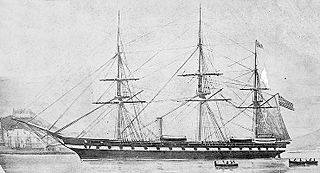
USS Roanoke was a wooden-hulled Merrimack-class screw frigate built for the United States Navy in the mid-1850s. She served as flagship of the Home Squadron in the late 1850s and captured several Confederate ships after the start of the American Civil War in 1861. The ship was converted into an ironclad monitor during 1862–63; the first ship with more than two gun turrets in history. Her conversion was not very successful as she rolled excessively and the weight of her armor and turrets strained her hull. Her deep draft meant that she could not operate off shallow Confederate ports and she was relegated to harbor defense at Hampton Roads, Virginia for the duration of the war. Roanoke was placed reserve after the war and sold for scrap in 1883.
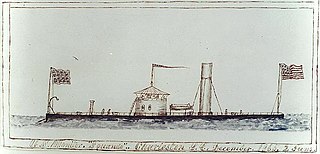
USS Squando was a Casco-class light draft monitor built during the American Civil War. Designed for service in rivers, the class required design changes due to the lack of seaworthiness of the first Casco-class vessel. Squando required her deck to be raised 22 inches (56 cm) before completion in order to provide more freeboard. Launched in late December 1864 or early January 1865, she was commissioned on June 6, 1865. Completed after the American Civil War had wound down, she served in the North Atlantic Squadron in 1865 and 1866 before being decommissioned in May of the latter year. After being renamed twice in 1869, she was sold in 1874 and then broken up.
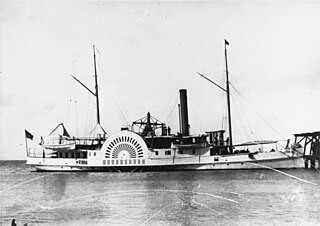
USS Delaware was a steamer acquired by the Union Navy for use during the American Civil War. She had a very active naval career as a gunboat for over three years, and after the war served as a revenue cutter for over 37 years. The steamer was sold to the private sector in 1903, and disappeared from shipping registers in 1919.

USS Morse was a ferryboat acquired by the Union Navy during the American Civil War.
The USS Beauregard began the war as a Confederate privateer. The Union Navy acquired the schooner from the prize court and outfitted the vessel for blockade duty.
USS Isaac N. Seymour, also referred to variously as Seymour, I. N. Seymour and J. N. Seymour, was a steamer acquired by the Union Navy for use as a gunboat during the American Civil War. She was used by the Navy as a littoral ship in fire support, supply and blockading roles.

CSS Fanny was a small propeller-driven steam tug used by the Confederate States Navy to defend the sounds of northeastern North Carolina in the American Civil War. Originally armed as a gunboat and operated by the Union, she was captured in October 1861 by the Confederate Navy, and later lost at the Battle of Elizabeth City in February 1862. Due to being used as an observation balloon platform, Fanny is sometimes credited with being the first self-propelled aircraft carrier.

USS Bazely was a steamer acquired by the Union Navy during the American Civil War. She was used by the Union Navy in a tugboat/patrol boat role in support of the Union Navy blockade of Confederate waterways.
USS Jasmine was a steam tugboat acquired by the Union Navy during the American Civil War. She was used by the Union Navy as an armed tugboat in support of the Union Navy blockade of Confederate waterways.

CSS Tuscaloosa was an ironclad warship that served in the Confederate States Navy during the American Civil War. Construction began in May 1862, under a contract with Henry D. Bassett. Her engines were taken from the steamboat Chewala, and she was armored with 4 inches (10 cm) of iron and armed with four cannons. In January 1863, she was launched, and traveled down to Mobile, Alabama for service on Mobile Bay. Both Tuscaloosa and her sister ship CSS Huntsville were found to be too slow for practical use, and were relegated to service as floating batteries. Union forces captured Mobile in April 1865, and Tuscaloosa was scuttled on April 12, as she was unable to escape due to an inability to steam against the current on the Spanish River. Her wreck was discovered in the 1980s.
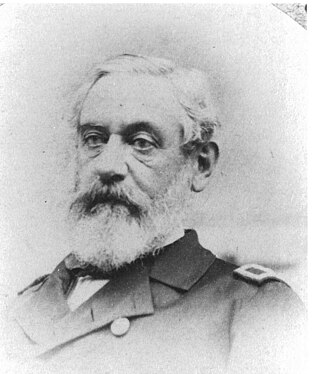
Gustavus Hall Scott was an officer in the United States Navy who served in the Second Seminole War and the American Civil War. He rose to the rank of rear admiral and late in his career was commander-in-chief of the North Atlantic Squadron.

CSS Junaluska, also known as Younalaska, was a screw steamer tugboat that saw service with the Confederate States Navy during the American Civil War. Built in Philadelphia, Pennsylvania, in 1860, she was purchased by the Confederates at Norfolk, Virginia, in 1861. Serving off of the coasts of Virginia and North Carolina, she participated in the capture of the gunboat USS Fanny on October 1, 1861, and later in a raid on a Union campsite. She continued to serve along the North Carolina coast until August 1862, when she was sold and broken up.

The Huntsville-class ironclads consisted of two casemate ironclads ordered by the Confederate States Navy in 1862 to defend Mobile, Alabama, during the American Civil War. Completed the following year, they used propulsion machinery taken from steamboats, and were intended to be armored with 4 inches (102 mm) of wrought iron and armed with four cannons. Both CSS Tuscaloosa and her sister ship CSS Huntsville were found to be too slow for practical use, and were relegated to service as floating batteries. Union forces captured Mobile in April 1865, and the sisters were scuttled on April 12, as they were unable to escape due to an inability to steam against the current on the Spanish River.













